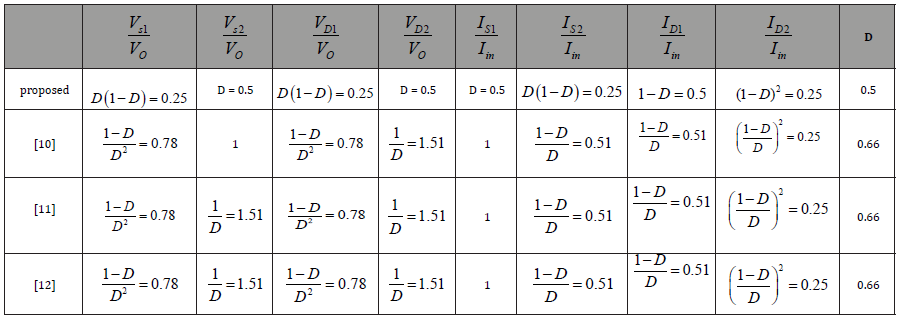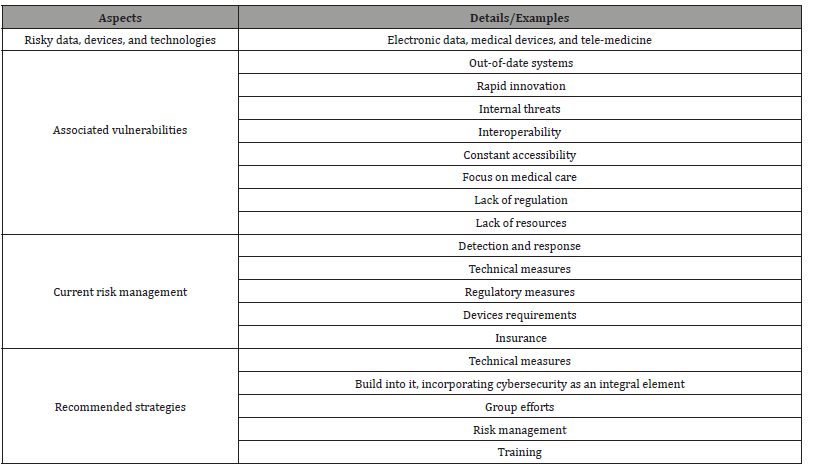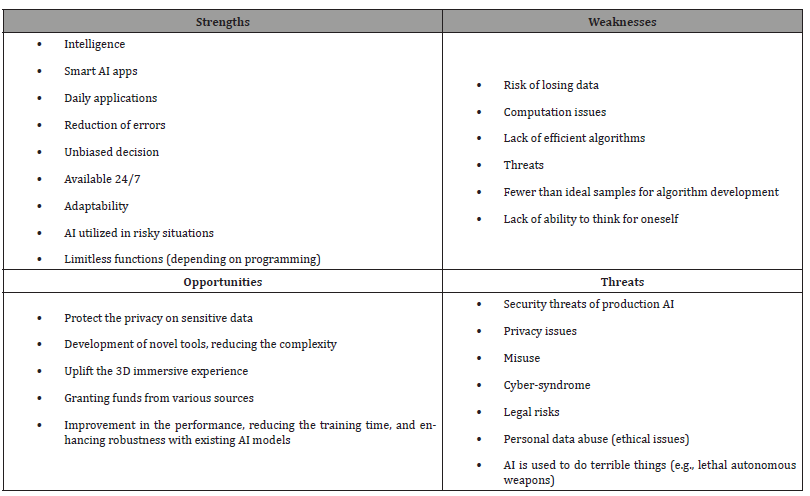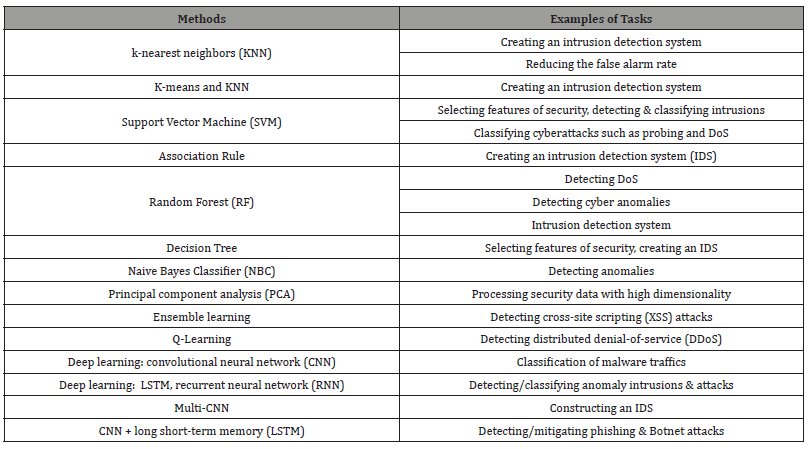 Research Article
Research Article
AI/ML, Data Science, and Automation in Cybersecurity: Methods and Applications in Healthcare
Cheryl Ann Alexander1* and Lidong Wang2
1Institute for IT Innovation and Smart Health, Mississippi, USA
2Institute for Systems Engineering Research, Mississippi State University, Mississippi, USA
Cheryl Ann Alexander, Institute for IT Innovation and Smart Health, Mississippi, USA
Received Date:May 10, 2024; Published Date:June 06, 2024
Abstract
The support of artificial intelligence (AI)/machine learning (ML), data science, and automation in cybersecurity are introduced in this paper, respectively. Their specific methods or tools in cybersecurity are discussed. The applications of AI/ML, data science, and automation in healthcare cybersecurity are presented as case studies, respectively. Both defenders and cyber criminals have access to AI/ML, data science, and automation. There are challenges in practicing robust cybersecurity. It is significant to maintain strict cybersecurity policies and use advanced or updated technologies for the detection, prevention, or mitigation of cyberattacks and cyber incidents. Healthcare depends on cybersecurity to keep personal health information (PHI) safe because healthcare data is either in motion or at rest. Cybersecurity in healthcare then becomes a primary concern to meet HIPAA standards and hospital standards. Healthcare information travels more often than ever before as providers are using mobile devices, telemedicine, and mobile imaging and diagnostics.
Keywords:cybersecurity; artificial intelligence (AI); machine learning (ML); deep learning (DL); data science; cybersecurity automation; healthcare
Introduction
Detecting threats and protecting systems and their data
sources, including intrusion detection/prevention systems,
identity and access management, fraud detection/anti-fraud, data
loss prevention, antivirus/antimalware, and risk and compliance
management is a function of AI-based tools. There are challenges
in the training of artificial intelligence (AI)/machine learning (ML)
models for complex data due to
1. data from various sensors (possible problems in data
fusion),
2. noisy data streams, and
3. data with various modalities.
Data science has the potential in cybersecurity. It offers tools for synthesizing a high volume of data quickly, detecting unforeseen patterns, etc. The smart adversary is a new threat model, in which an adversary employs sophisticated techniques for attacks. The attacks can target training data, testing data, and model parameters in AI/ML. The smart adversary can erode confidence and trust in an AI/ML system, target a specific class for misclassifications, and evade automatic detection by obfuscation. ML should utilize various feature vectors and objective functions to minimize the impacts of the smart adversary [1].
The utilization of an automated method for cybersecurity threat intelligence was studied. The selected use case is an international leading organization in cybersecurity, demonstrating new dynamic ways to support decision-making at all levels (operational, tactical, and strategic) while being under attacks. An integrated architecture was developed that combines cyber threat intelligence (CTI) and dynamic risk assessment and management (DRA/DRM). It is based on ontologies, Semantic Web Rule Language (SWRL) rules, and the utilization of a reasoner [2]. Table 1 [3] lists some attacks, descriptions, and their targeted objects. Table 2 [4] shows some risky sources (data, devices, and technologies) in healthcare, associated vulnerabilities, current risk management, and recommended strategies.
Table 1:Attacks and targeted objects.

Table 2:Risky sources, associated vulnerabilities, current risk management, and recommended strategies.

The objective of this paper is to introduce the methods of AI/ ML, data science, and automation in cybersecurity, and discuss their applications in cybersecurity of healthcare. The subsequent sections of the paper are organized as follows: the second section, the third section, and the fourth section introduce AI/ML, data science, and automation in cybersecurity, respectively. The fifth section, the sixth section, and the seventh section present AI/ ML, data science, and automation in cybersecurity of healthcare, respectively. The eighth section is the conclusion.
AI/ML in Cybersecurity
AI continuously monitors network traffic, user behaviors, and system anomalies. AI swiftly recognizes unusual patterns, revealing cyberattacks. An instant response can be proactive for threat projections and can foster an immediate response, which can prevent a breach. Furthermore, new threats can teach AIpowered cybersecurity to adapt and learn when new threats arise. Predictive analytics can forecast possible vulnerabilities and further recommend actions. AI-powered cybersecurity can also understand and learn new threats. AI uses predictive analysis and AI-powered cybersecurity tools that can estimate many vulnerabilities and therefore recommend or predict actions. A comprehensive view of vulnerabilities and potential actions to avoid threats leads AI to correlate the data from a multitude of sources, which can provide a comprehensive point of view for potential threats. This becomes a holistic approach enabling early detection of any advanced or mutistaged attacks. AI streamlines administrative activities, improving efficiency.
Cybersecurity AI acts by analyzing data stream within the system and constructing some interpretation of normal or abnormal for users, computers, or other devices. However, cybersecurity AI is very competent in recognizing the difference between normal network activities and the works of a malicious actor, but AI can issue an immediate response to stop the spread of an attack. AI applications in cybersecurity, healthcare, etc. were introduced. A SWOT analysis of AI is shown in Table 3 [5]. Intelligence, security, risks/threats, privacy, etc. are included in the table.
Table 3:SWOT analysis of AI.

Malicious actors also use AI to design and execute attacks; ransomware, rapid exploitation of vulnerabilities, developing phishing emails, deep target reconnaissance, developing complex malware code, automated attacks, etc. Cyber criminals have developed complex malware codes, automation of attacks, etc. Malicious actors have also multiplied AI capacity, including human impersonation, password guessing, building better malware, penetration testing tools, and stealth attacks. AI-generated phishing emails may be opened at a higher rate due to the ability of AI to target users and recognize patterns. For example, ChatGPT, an AIpowered chatbot can be used in the development of malware and ransomware.
An extensive view of ML algorithms was provided, focusing on how they can be used for intelligent data analytics and automation in cybersecurity. Potential real-world use cases were explored where automation, data-driven intelligence, and decision-making enable more proactive cyber protection than traditional methods. Various ML methods used in cybersecurity are shown in Table 4 [6].
Table 4:Various ML methods and their tasks in cybersecurity.

Data Science in Cybersecurity
Data science is a multidisciplinary field, combining math,
statistics, computer science, AI/ML, specialized programming,
sophisticated analytics, and domain expertise to extract data and
expose valued insights from the data. By using various tools and
techniques, data can be studied and analyzed in massive volumes,
finding unseen patterns, and drawing meaningful insights from
the data. Listed below are some of the major applications of data
science in cybersecurity:
a. ML is a data science tool used for anomaly detection where
ML algorithms are used to analyze massive amounts of datasets
and identification of any abnormal patterns or behaviors.
b. ML applies predictive cybersecurity as ML models may be
taught to predict prospective cyber threats before they occur.
c. Data science has a critical role in analyzing the scope
of a security incident response and identification of any
compromised data. ML models can assist in tracing the origin
of the attack and assist in mitigating the damage.
How cybersecurity data science is applied to the data-driven process for intelligent decision-making in smart cybersecurity services and systems was studied. A generic multi-layered framework of a cybersecurity data science model was developed based on ML. In the framework, data are captured from various sources, and data analytics complement the latest data-driven patterns to provide smart cybersecurity solutions. The framework is shown in Figure 1 [7].

Automation in Cybersecurity
The integration of automated infrastructure management (AIM) into cybersecurity was discussed. AIM’s automation of infrastructure management processes improves the effectiveness and speed of cybersecurity measures [8]. A risk analysis method was developed, and major steps were followed that included deciding the automation level, finding cyberattack targets, discovering cyberattack methods, defining cyberattack consequences, and performing risk ratio evaluation.
The cybersecurity automation system is an advanced system driven by AI/ML, involving the automation of cybersecurity procedures so that they are faster and work more effectively. Streamlining manual and often arduous tasks, cybersecurity automation systematizes the workflow. Because cybersecurity automated systems can analyze real-time data, they provide efficient protection against cyberattacks and require only the implementation of automated systems. However, automated compliance observation is utilized to monitor networks and systems for compliance with standards and regulations in healthcare, which helps identify and handle any potential compliance problems. Automated intelligence collection, penetration testing, and AI/ML, etc. are excellent models of automation in cybersecurity.
Through the conduction of malware analysis, detection
of data exfiltration, implementation of vulnerability scanning
technology, and blocking of common installation paths, defenders
can permanently leverage automation. However, malicious actors
can still use automated software to recognize invaluable data such
as credit cards and passwords. Although most automated cyber
intelligence tools were designed to secure systems, embracing
systems for security monitoring or alerting, network intrusion
detection and prevention, and vulnerability management, is also
suggested. Various types of security automation tools include:
a. Security information and event management (SIEM) tools
b. Security orchestration, automation, and response (SOAR)
tools
c. Vulnerability management tools-Automatically scan IT
resources for vulnerabilities, recognize flaws, classify them,
prioritize the risks, and propose remediation activities.
d. Endpoint protection tools-The endpoints include network
connections, Internet of Things (IoT) devices, cloud-based
applications, PCs, etc. Major categories of endpoint protection
tools contain anti-malware solutions, response software,
endpoint detection, anti-malware solutions, etc.
AI/ML in the Cybersecurity of Healthcare
Impactful vectors directed at healthcare include wireless
technology compromise (especially Bluetooth and Wi-Fi),
compromise of vulnerabilities, phishing attacks, compromise of
remote access technologies, credential compromise, etc. Major
contributions of AI to healthcare cybersecurity include the
following:
a. Identification of vulnerabilities and threats: AI can
examine patterns in network traffic and user activity in the
healthcare environment to flag any abnormalities from normal
actions. Natural language processing (NLP) scans for social
engineering attacks or documents and communications to
identify signs of emergent cyber threats.
b. Behavioral modeling is used for identifying and
responding to breaches using AI to improve identification and
isolation of threats much quicker than traditional security
methods when a security breach does occur.
c. Medical devices are protected from attacks: If left exposed
to remote breaches smart medical devices pose significant
threats to patient safety but AI helps address the most
challenging barriers to safeguarding these devices.
d. Increasing accuracy and efficiency: AI analyzes patient
outcomes and treatment efficiency based on historical data,
which helps healthcare providers enhance their practices and
provide better patient care quality.
e. Ensure privacy and compliance: There is a need for AIdriven
systems to constantly monitor data access and usage,
guaranteeing that only approved employees can access the
EMR/EHR/PHI, to meet conditions of regulations like HIPAA. AI
can also assist in audits and reports, streamlining the process
of developing fulfillment to regulatory authorities. Automating
data access tracking helps AI reduce administrative burdens
connected with compliance documentation.
f. Enhancing third-party risk management: AI rapidly
analyzes questionnaires, audit security assessments,
documents, and additional materials from third-party payors
to weigh their cyber risk levels in real time.
Healthcare use cases of ML for cybersecurity include predictive analytics visualizing cybersecurity threats in a user interface for malware detection, anomaly detection for cybersecurity, etc.
Data Science in the Cybersecurity of Healthcare
Patient information, clinical records, analysis, and
interpretation of medical data are analyzed by data science as the
collection and analysis occur by data science and ML. Because the
purpose of advanced data science and ML algorithms is leveraging
advanced analytics, AI/ML works together to gain significant
information from healthcare data. Working together, data science
and cybersecurity work together to ensure the safety of patient
information yet able to harness the power of data for better
healthcare outcomes, summarized by the following:
a. Unauthorized retrieval of patient records or unusual
data transfers inside a healthcare system can be an anomaly
detection.
b. User and entity behavior analytics (UEBA) is a data
science method that focuses on observing and analyzing user
and entity performance within the healthcare network. UEBA
establishes a baseline user profile that detects deviances from
normal performance and triggers alerts. Extremely successful
in the identification of insider threats and protects from
unauthorized access to patient data.
c. Data science can design role-based access control systems,
while cybersecurity confirms that unauthorized persons cannot
gain access to sensitive patient data.
d. Encrypting data at rest and in transit is crucial to protect
patient information. Data science can be used for implementing
encryption techniques whereas cybersecurity can ensure their
efficacy.
e. Data science facilitates the design of secure data-sharing
protocols, certifying that sensitive patient data is only revealed
to authorized personnel. Workers, staff, and third parties who
do not have the encryption key cannot access the data. This
aids healthcare facilities in tracking and auditing data access,
improving security and accountability.
f. With the number of IoT and IoMT in healthcare, data
science must control and interpret their data for better patient
care, while cybersecurity guarantees the defense of these
devices from probable attacks.
g. Threat intelligence is the process by which data
science gathers data on the latest cybersecurity threats and
vulnerabilities. Data science also aids the assimilation of
threat intelligence into healthcare cybersecurity. Furthermore,
healthcare organizations can stay updated on emergent threats
and tailor a security package to address their specific security
needs and specific risks. By staying updated on emerging
threats, healthcare organizations can tailor their security
measures to address these specific risks.
h. Data Science optimizes telehealth services by analyzing
patient data for remote diagnostics, while cybersecurity
safeguards the protected transmission of patient data in transit
over digital channels.
i. Routine audits are the key to complying with regulations
like HIPAA. Data science can aid in compliance monitoring
and identification of any areas of noncompliance, meanwhile,
cybersecurity can ensure data is protected over the entire
process.
j. Data privacy is the primary consideration in healthcare
and medical data privacy must be guaranteed while detecting
fraudulent data and must not lose its usefulness. Data scientists
must construct frameworks and systems to protect sensitive
data such as insurance and billing information. The need to
uncover fraud is essential. A healthcare organization should be
updated regularly to stop any data breaches.
k. Equalizing patient privacy for the greater good of public
health is yet a complex ethical dispute. There needs to be
a collaboration between data science and cybersecurity to
strike the right balance between data science collaboration
and cybersecurity to protect patient data while granting data
sharing for research purposes.
Automation in the Cybersecurity of Healthcare
Automation can fight these tactics if used correctly by defenders.
Healthcare entities can utilize automation to build detections for
browsing behaviors and collecting visitor logs. When defenders
use automated technologies, healthcare organizations can detect
threats more rapidly. Unfortunately, malicious actors may also
find automation useful in cybercrime efforts. Threat actors can
utilize automation to move through phases faster. In the healthcare
environment, data privacy and compliance are key. Automation,
therefore, reveals itself as an impressive tool. Enhancing security
with automation is as follows:
a. Automation in identity and access management (IAM)
processes: IAM harnesses biometric recognition, supported
by automation, to admit access. Automation also quickens
dynamic role-based access controls, adapting user permissions
in real time in response to a change in responsibilities or duties.
b. Continuous monitoring and anomaly detection for data
security: In scenarios like unauthorized data extractions from
electronic health records (EHRs), immediately trigger alarms,
guaranteeing a quick response.
c. Automated threat detection and prevention systems:
When malicious payloads are detected on MRI or CT scan
consoles, the systems can promptly insulate the devices,
preserving wider hospital network reliability.
d. Integration of automation with security information
and event management (SIEM) systems: Critical warnings
are automatically highlighted, certifying timely mitigation.
Automation also accelerates the creation of a visual dashboard
within SIEMs for real-time threat landscapes.
e. Automated compliance assessments: Automated tools
leverage AI to conduct multidimensional compliance checks.
NLP can semantically analyze EHR annotations and access logs,
identifying potential unauthorized access or data mishandling.
Acknowledgement
The authors would like to thank Technology and Healthcare Solutions, Mississippi, USA for its support.
Conflict of Interest
Authors declare no conflict of interest.
References
- Yener B, Gal T (2019) Cybersecurity in the era of data science: Examining new adversarial models. IEEE Security & Privacy 17(6): 46-53.
- Riesco R, Villagrá V A (2019) Leveraging cyber threat intelligence for a dynamic risk framework: Automation by using a semantic reasoner and a new combination of standards (STIX™, SWRL and OWL). International Journal of Information Security 18(6): 715-739.
- Tubis AA, Werbińska Wojciechowska S, Góralczyk M, Wróblewski A, Ziętek B (2020) Cyber-attacks risk analysis method for different levels of automation of mining processes in mines based on fuzzy theory use. Sensors 20(24): 7210.
- Wasserman L, Wasserman Y (2022) Hospital cybersecurity risks and gaps: Review (for the non-cyber professional). Frontiers in Digital Health 4: 862221.
- Sharma N, Jindal N (2023) Emerging artificial intelligence applications: metaverse, IoT, cybersecurity, healthcare-an overview. Multimedia Tools and Applications, 1-29.
- Sarker IH (2023) Machine learning for intelligent data analysis and automation in cybersecurity: current and future prospects. Annals of Data Science 10(6): 1473-1498.
- Sarker IH, Kayes ASM, Badsha S, Alqahtani H, Watters P, et al. (2020) Cybersecurity data science: an overview from machine learning perspective. Journal of Big data 7: 1-29.
- Yaseen A (2024) Enhancing Cybersecurity through Automated Infrastructure Management: A Comprehensive Study on Optimizing Security Measures. Quarterly Journal of Emerging Technologies and Innovations 9(1): 38-60.
-
Cheryl Ann Alexander* and Lidong Wang. AI/ML, Data Science, and Automation in Cybersecurity: Methods and Applications in Healthcare. On Journ of Robotics & Autom. 3(1): 2024. OJRAT.MS.ID.000551.
cybersecurity, artificial intelligence (AI), machine learning (ML), deep learning (DL), data science, cybersecurity automation, healthcare
-

This work is licensed under a Creative Commons Attribution-NonCommercial 4.0 International License.






